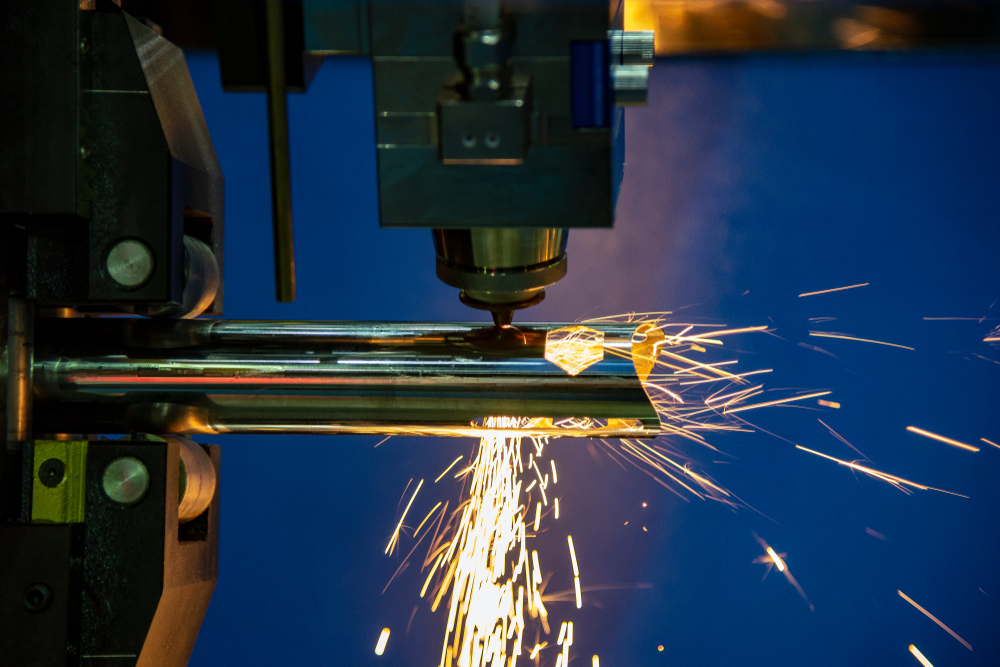Rotary Laser Cutting Vs. Flatbed Die Cutting: Pros And Cons
Not sure how to choose between a rotary laser cutter and a flatbed die cutter? KNS Metals breaks down everything you need to know, from what each are used for to their individual pros and cons.
What is Rotary Laser Cutting?
Rotary laser cutting is a process which slightly differs from Flatbed laser cutting. A specialised Laser unit directs the beam while the unit is able to move along a 3D axis. Taking into consideration the spead of the laser beam, the angle & height at which it hits the given material will determine the depth and width of the cut. Together this allows for cutting complex curves and custom shapes around tubes, pipes, I-beams and more.
What is a Rotary Laser Level Used for?
Rotary laser cutting is a popular method to replace traditional manufacturing techniques such as milling, punching, drilling and sawing. It is used primarily to cut various components and shapes intubing and pipes, as well as in bevelling to assist during the fabrication stage.
The rotary laser cutting process takes multiple steps to complete, including having the tube or piece of metal clamped firmly between rotating jaws and pneumatically controlled tail stock.
Pros of Rotary Laser Cutting
- Greater Flexibility: With laser cutting, technicians don’t need to constantly change out their tools for each new cut. This makes it much more efficient and easier to work with different shapes sharing the same thickness, and when cutting multiple or complex shapes.
- Greater Flexibility: With laser cutting, technicians don’t need to constantly change out their tools for each new cut. This makes it much more efficient and easier to work with different shapes sharing the same thickness, and when cutting multiple or complex shapes.
- Greater Flexibility: With laser cutting, technicians don’t need to constantly change out their tools for each new cut. This makes it much more efficient and easier to work with different shapes sharing the same thickness, and when cutting multiple or complex shapes.
- Faster Speeds: Unlike mechanical cutting methods, laser cutting is a quick process, especially when the cuts are complex. Compared to other thermal cutting techniques, such as flame and plasma cutting, a laser cutter is far more efficient in cutting through various thicknesses.
- Automation Capabilities: Rotary laser cutters offer a lot of automation capabilities. While there is still a role for the operator in the process, most machines are equipped with feeding systems and follow-up conveyors to assist in removing several steps.
- Contactless Cutting: The beam alone will contact the material you are cutting, leaving no mechanical friction causing wear on your tools.
- Greater Quality: With the right set-up and application, rotary laser cutting leaves but a minuscule burr, depending on thickness and material. There is also a smaller zone affected by the heat.
Cons of Rotary Laser Cutting
- Necessary Expertise for Operations: A laser cutter can produce stunning results, but only if you have a specialist operator who knows how to set it up correctly. With the right setup, you can ensure all your cuts meet every expectation of what this technology is capable of.
- Limits to Thickness of Metals: It is impossible to cut very thick plates with a laser cutter because it has a higher power than other thermal cutting technologies. The maximum permissible thickness is determined by the equipment and expertise available. Metal fabricators, on average, laser cut metal up to 15 or 20 millimetres in thickness.
- Upfront Investment: Rotary laser cutters require a significant, upfront investment to operate, often far more than waterjet and plasma cutters. It is worth noting that the greater efficiency and reduction in running costs will reduce this expense long term.
- Fumes: This thermal cutting method still leaves the material melting, creating emissions of potentially dangerous gases and fumes.
What is Flatbed Die Cutting?
Flatbed die cutting is a process that uses an ultra-sharp, hydraulic steel rule die to ‘click cut’ through paper or other materials. The die is mounted on a flatbed press, with the material to be cut fed into the machine as a means of creating a specific shape or design.
Pros of Flatbed Die Cutting
- Thicker Materials: A flatbed die cutter can handle far denser and thicker materials, given how the machine itself can be opened wider whilst feeding them through.
- Greater Variety of Materials: The design of the machine also means it can handle a larger variety of materials; whether they come in sheets or rolls, or are thick or thin.
- More Affordable: With lower tooling and machine costs to facilitate the flatbed die cutting, introducing this into your workshop or operations would be far more affordable.
- Reduced Waste: All parts are grouped more efficiently on the sheet, creating fewer scrap materials and waste.
Cons of Flatbed Die Cutting
- Slower Production Speeds: Flatbed die cutting is a slower production process. If you have a lot of manufacturing demands, this may be an issue.
- No Multi-Function Features: Unlike rotary die cutting, which may print, perforate, and laminate, there is no multi-function feature on this model.
- Longer Set-Up Times: The mechanism behind the steel rule die means a flatbed die cutter will take longer to set up.
- Less Precision: Flatbed die cutting isn’t as precise as rotary die cutting, although the cuts are still neat and accurate.
Speak with the specialists at KNS Metals to learn more about rotary laser cutting and the other methods we have available.


